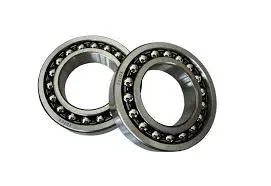
Dec . 07, 2024 04:13 Back to list
double angular contact ball bearing
Understanding Double Angular Contact Ball Bearings
Double angular contact ball bearings are precision-engineered components used in various machinery and equipment, where high precision, durability, and reliability are critical. They are a type of rolling-element bearing that can support both axial and radial loads, making them essential in applications like automotive, aerospace, and machine tool industries.
Structure and Design
The fundamental design of a double angular contact ball bearing includes two rings (inner and outer), an array of balls, and typically a cage to keep the balls evenly spaced. The unique feature of these bearings is their geometry each raceway is angled, which allows for the distribution of load across the balls when subjected to forces. This angular contact enables the bearing to handle both radial loads and axial loads applied in either direction.
The contact angle is a critical design feature that influences a bearing's load capacity and stiffness. Bearings with a larger contact angle can support heavier axial loads but generally have a lower radial load capacity. Conversely, a smaller contact angle allows for more efficient radial load handling but reduces axial load capabilities. Therefore, selecting the correct contact angle based on the application's specific needs is crucial for optimal performance.
Applications
Double angular contact ball bearings are prevalent in high-speed applications where precision and performance matter. One of their primary uses is in the spindles of machine tools, where they facilitate smooth rotations and can endure high-speed operations. Additionally, they find applications in the automotive sector, particularly in the wheel hubs of vehicles, where they help maintain stability and support hub assemblies under various loads and conditions.
Another critical area is in electric motors, where these bearings ensure the smooth operation of rotor shafts. Industries relying on conveyor systems, robotics, and high-performance machinery also utilize double angular contact ball bearings due to their ability to handle inclined loads and maintain operational efficiency over extended periods.
Advantages
The advantages of double angular contact ball bearings over other types of bearings are numerous. Firstly, their ability to sustain axial and radial loads simultaneously provides a compact solution for various applications, reducing the need for multiple bearing systems. This not only saves space but also simplifies design and assembly processes.
Secondly, these bearings exhibit low friction, which translates to enhanced efficiency and longer service life for the machinery they support. Their robust design allows them to operate effectively under extreme conditions, including high speeds and varying temperatures, making them highly versatile.
double angular contact ball bearing

Another significant advantage is the ease of maintenance
. Double angular contact ball bearings are typically lubricated, either through grease or oil, which helps maintain their performance and longevity. Manufacturers often design them for easy disassembly and re-lubrication, reducing downtime and maintenance costs.Selection Criteria
When selecting double angular contact ball bearings for specific applications, several factors must be considered
1. Load Type Understand the application requirements to determine the type and magnitude of loads (radial and axial) the bearings need to support.
2. Speed Consider the operational speed of the machinery. Bearings need to be rated for the specific speeds they will encounter during use.
3. Environment Assess the working environment, including temperature, humidity, and the presence of contaminants. Special seals and materials may be required for harsh environments.
4. Lubrication Decide on the most appropriate lubrication method—grease-filled or oil-lubricated—and ensure it aligns with the operational needs of the bearings.
5. Alignment and Installation Proper alignment during installation is crucial for the effective functioning of double angular contact ball bearings. Misalignment can lead to premature wear and failure.
Conclusion
Double angular contact ball bearings play a pivotal role in modern engineering applications. Their unique design allows for the efficient handling of mixed loads, making them indispensable in high-precision environments. By understanding their structure, advantages, and selection criteria, engineers can make informed choices that enhance machinery performance and reliability. With ongoing advancements in materials and manufacturing techniques, the future of double angular contact ball bearings looks promising, continuing to meet the demands of increasingly sophisticated industrial applications.
Latest news
-
Premium Deep Groove Ball Bearings | High Speed & Reliability
NewsAug.29,2025
-
Durable Scaffolding Clamps - Secure & Reliable Tube Connectors
NewsAug.28,2025
-
Common Failures in Thrust Ball Bearings and Solutions
NewsAug.22,2025
-
How Tapered Roller Bearings Can Take Shock Loads
NewsAug.22,2025
-
Angular Bearings in High-Precision Spindles
NewsAug.22,2025
-
The Impact of Misalignment on Cylindrical Roller Bearing Performance
NewsAug.22,2025
